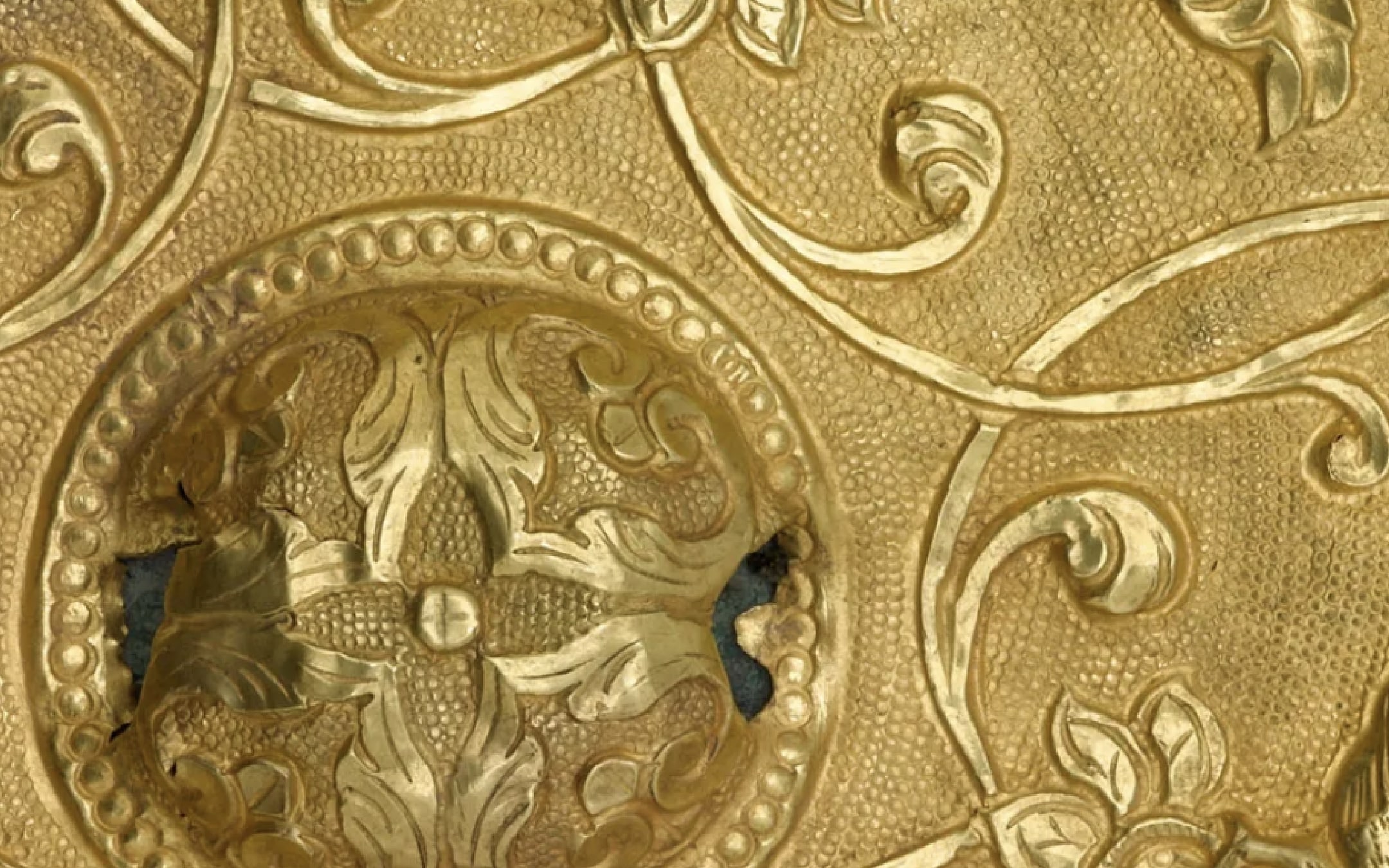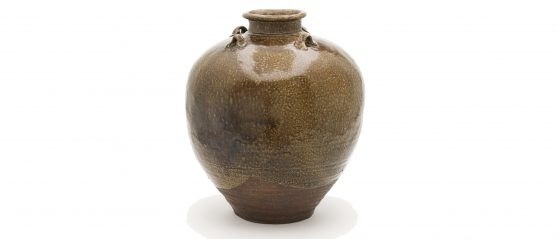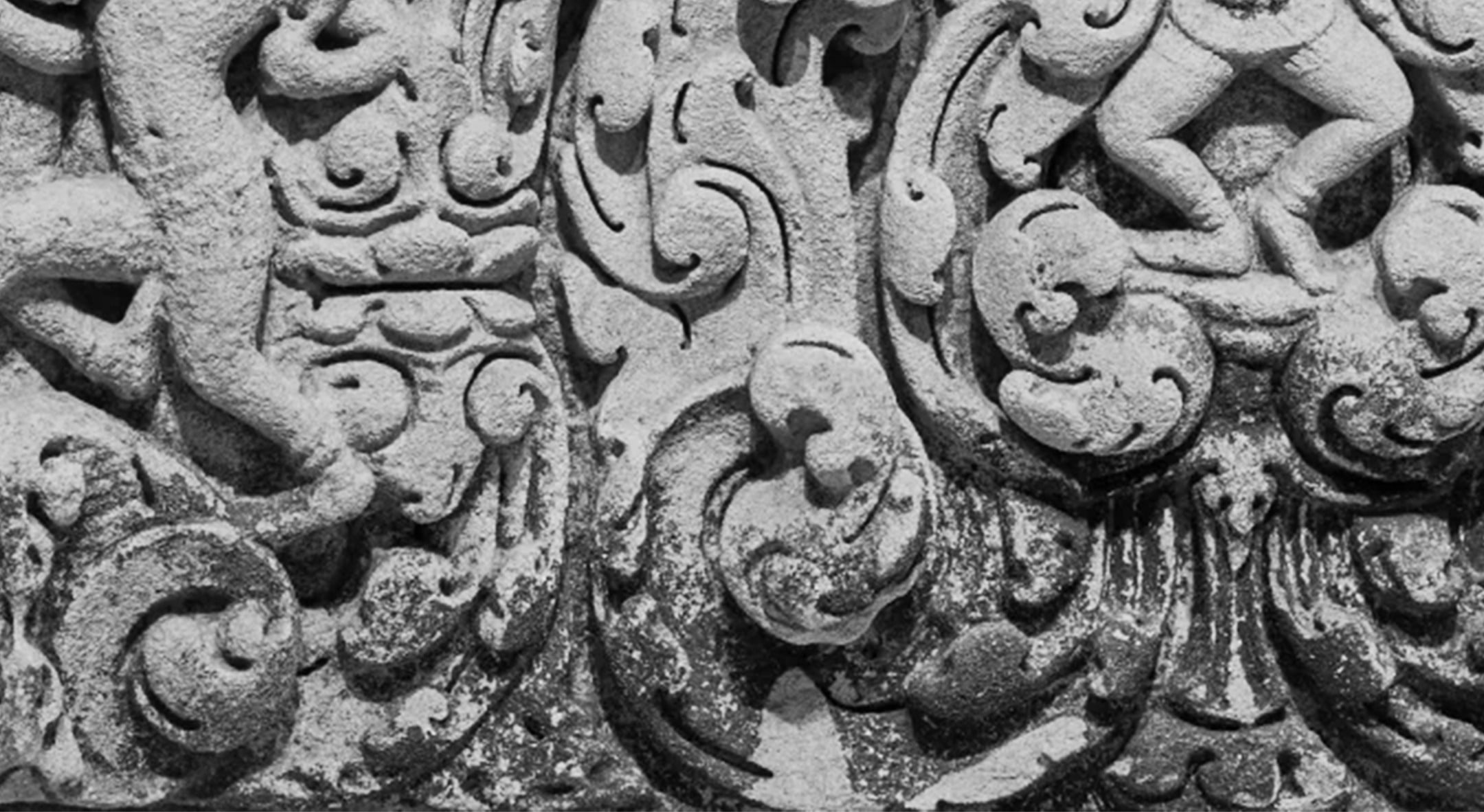February 22–July 27, 2014
-
Dates
-
Location
Arthur M. Sackler Gallery
-
Collection Area
Japanese Art
The power of seeing: to discern, distinguish, define. The power of owning: to possess, to share, to transmit. The power of naming: to designate, to define, to give meaning. The power of displaying: to show, to ornament, to enrobe. The power of writing: to describe, to record, to remember.
Japanese collectors have long engaged with objects through the practice of formalized tea presentation called chanoyu. Within the compact and focused setting of the tearoom, they singled out exceptional works through use, scrutiny, and discussion. They gave added distinction to stellar tea-leaf storage jars—utensils of imposing scale and presence—by awarding them personal names and adorning them with precious textiles.
This powerful process of seeing and naming created the tea-leaf storage jar named Chigusa. It transformed an imported Chinese jar from a practical container into a vessel worthy of display, ornament, and contemplation, although its practicality did not cease to be important. Remarkably, diaries kept by sixteenth-century tea participants record in great detail exactly what they admired when viewing Chigusa. The diaries allow us to see the jar through the eyes of these tea men.
Chigusa is accompanied by storage boxes, textiles, and documents that accumulated in the course of its changing ownership. This cumulative assemblage of material and meaning created the jar we see today. Chigusa also appears among other cherished objects—calligraphy by Chinese monks, Chinese and Korean tea bowls, and Japanese stoneware jars and wooden vessels—that were among the diverse ensembles of utensils used and enjoyed during this formative era of Japanese tea culture.
Two related exhibitions expand upon our understanding of Chigusa. Jars, which looks at the Chinese model of the storage jar and its expansion to kilns in Southeast Asia and Japan, is in Sackler Gallery sublevel 3 (opening March 15). Chinese Ceramics for Tea in Japan, an exhibition of tea utensils, is in the Freer Gallery of Art (opening March 8).
Chigusa and its accessories were purchased by the Freer Gallery of Art; they are designated by numbers beginning FSC-P.
Images

Tea-leaf storage jar named Chigusa
Image 1 of 13
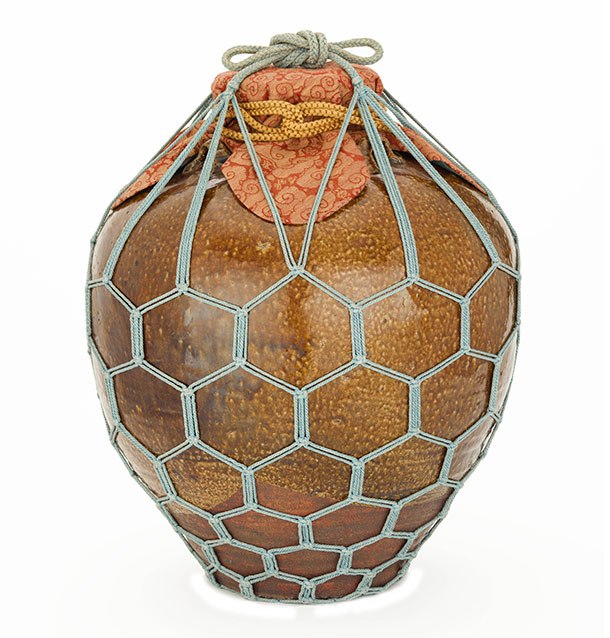
Chigusa dressed in its net bag and original mouth cover
Image 2 of 13

Chigusa dressed in its new mouth cover, secured with an ornamental knot
Image 3 of 13
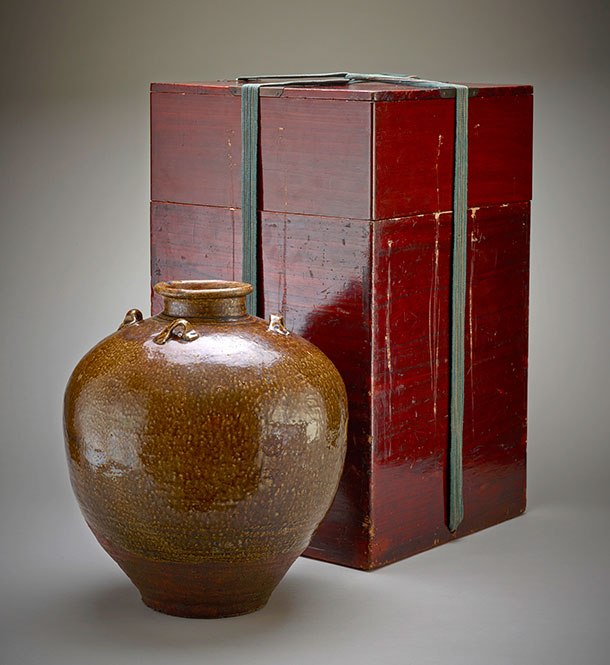
Chigusa and its innermost storage box
Image 4 of 13
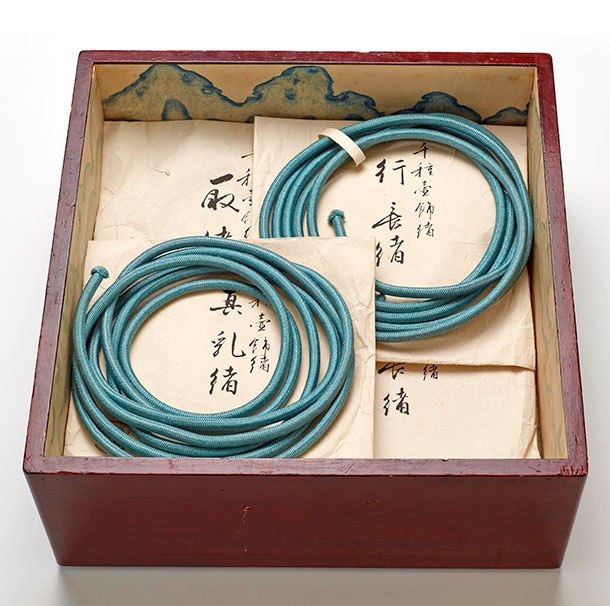
Tray for Chigusa’s inner storage box with ornamental cords and storage envelopes
Image 5 of 13
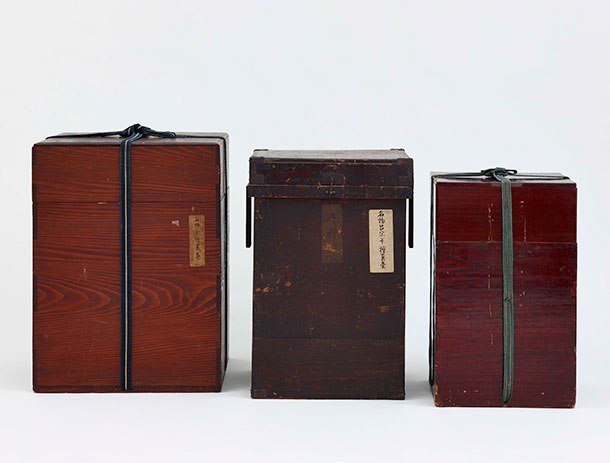
Set of three nesting storage boxes for Chigusa
Image 6 of 13
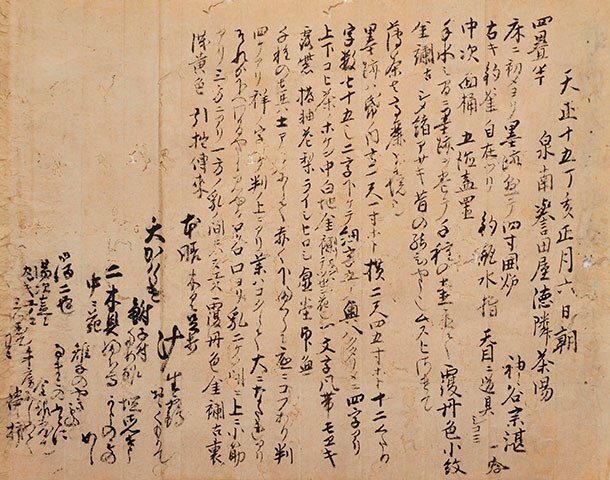
Record of a sixteeth-century viewing of Chigusa
Image 7 of 13
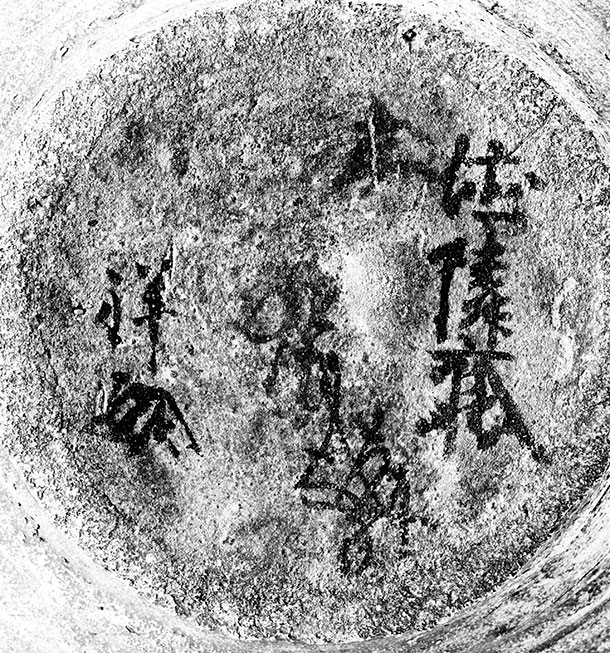
Base of Chigusa, showing ciphers and blisters
Image 8 of 13
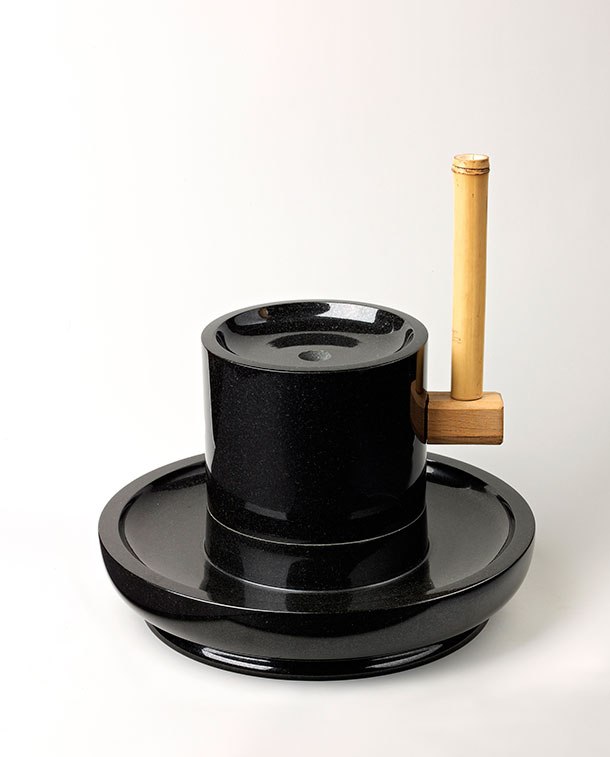
Hand mill for grinding tea
Image 9 of 13
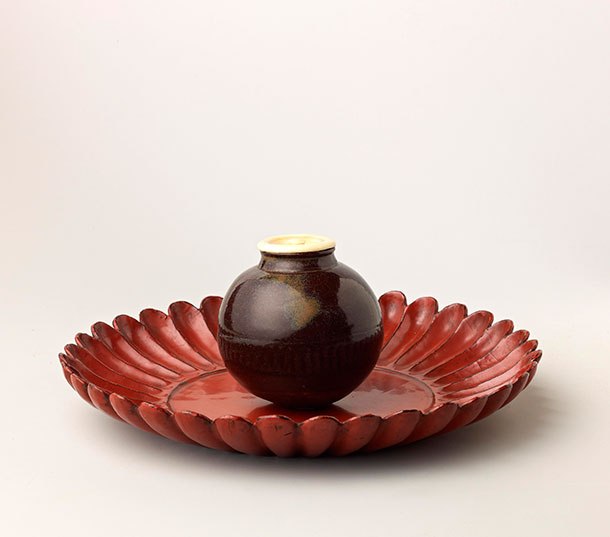
Tea caddy of bunrin shape named Ueda Bunrin, with lacquer tray
Image 10 of 13
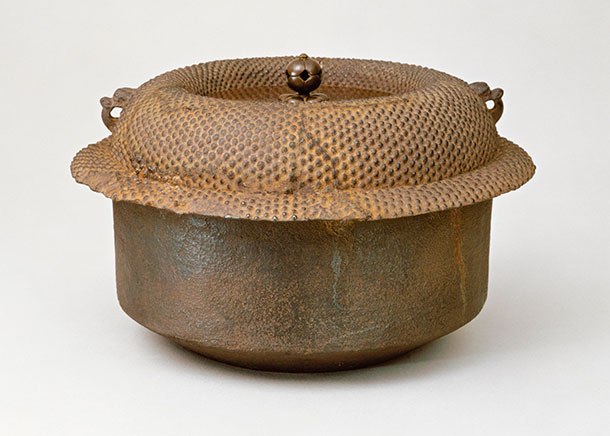
Kettle
Image 11 of 13
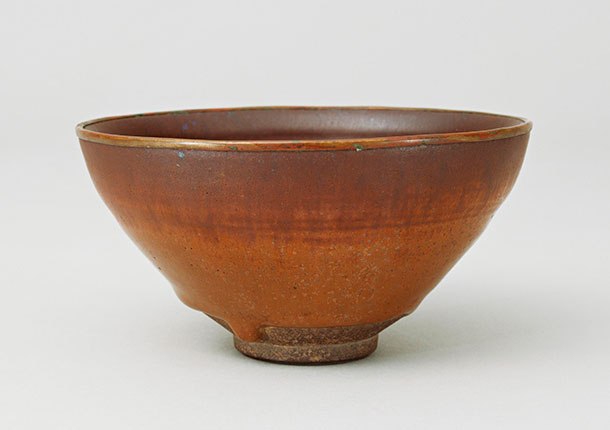
Tea bowl of tenmoku type
Image 12 of 13
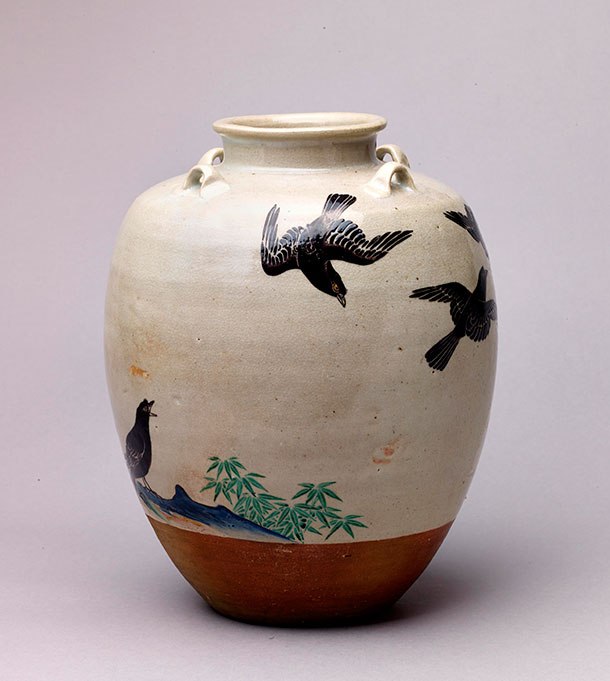
Jar with design of mynah birds
Image 13 of 13
Sixteenth-Century Textual References to Chigusa

Translated by Andrew M. Watsky
1. Accounting of Karamono [Karamono oyoso no kazu], circa 1570–73.1 Recorded in the entry for objects owned by Jū no Sōho.
Chikusa, the ōtsubo 千(ち)草(くさ)ノ(の)大(おお)ツボ
2. Tennōjiya Sōgyū, as recorded on Genki 4 [1573].1.24 in his tea diary of gatherings he attended as a guest, Sōgyū takaiki.2 The host was Jū no Sōho; the guests were Sōeki (Sen no Rikyū), Kusabeya Dōsetsu, and Tennōjiya Sōgyū.
Same [year], first month, twenty fourth day, morning
Jū no Sōho Eki, Setsu, Gyū
On the [sunken] hearth, Mitsuda Jōshū’s futon-shaped suspended kettle; a teoke and a kensantenmoku [tea bowl]. An ōtsubo, the first time I saw it. Chigusa 千草, Insetsu’s tsubo. From Insetsu’s time, there are a [mouth] cover and tsugari.3
3. Tennōjiya Sōgyū, as recorded on Tenshō 6 [1578].12.9 in his tea diary of gatherings he attended as a guest, Sōgyū takaiki.4 The host was Jū no Sōho; the guests were Tennōjiya Dōshitsu, Kusabeya Dōsetsu, and Tennōjiya Sōgyū.
Same [year], twelfth month, ninth day
Jū no Sōho Shitsu, Setsu, Gyū
Item: [Sunken] hearth, Zenkō’s suspended kettle. At the intermission, a Shigaraki [fresh-water container].After tea, the chatsubo Chigusa千種was brought out, and later was placed in the alcove.
Item: A tada tenmoku [tea bowl] was on a black [lacquer] stand with a foliate rim. A Bizen waste-water vessel.
4. Tennōjiya Sōgyū, as recorded on Tenshō 9 [1581].1.22 in his tea diary of gatherings he attended as a guest, Sōgyū takaiki.5 The host was Jū no Sōho; the guests were Zeniya Sōtotsu, and Tennōjiya Sōgyū.
Same [year], first month, twenty-second day, morning
Jū no Sōho Sōtotsu, Sōgyū
Item: Alcove: “Daruma” hanging; it was Insetsu’s “Daruma.”
Item: On the [sunken] hearth, a suspended kettle on a chain. Behind, a teoke and a Bizen waste-water vessel.
Item: A tada tenmoku [tea bowl] on a [lacquer] stand with a foliate rim.
After tea, the ōtsubo was brought out and shown, and then was placed in the alcove.
The above “Bodhidharma,” perhaps on silk, the brush of Jikifu [Japanese: Ko Chokufu; Chinese: Hu Zhifu, 13th century]; the inscription by Eseigan [i.e., Seigan Ryōe; Chinese: Xiyan Liaohui, 1198–1262].
The mounting: the upper and lower borders are light green[-ground] kinsha, the borders are white-ground kinsha, the inner borders and decorative hanging strips are small-figure dark-blue-ground white brocade.
5. Tennōjiya Sōgyū, as recorded on Tenshō 106 [1582].10.7 in his tea diary of gatherings he attended as a guest, Sōgyū takaiki.7 The host was Kondaya Tokurin; the guests were Tennōjiya Dōshitsu, Zeniya Sōtotsu, and Tennōjiya Sōgyū.
Same [year], tenth month, seventh day, morning
Kondaya Tokurin Dōshitsu, Sōtotsu, Sōgyū
Item: Alcove: the chatsubo Chigusa千草, from the start, by itself. Later it was taken down [to be examined]. Dōshitsu placed it [back] in the alcove.
6. Imai Sōkyū, as recorded on Tenshō 118 [1583].1.27 in his tea diary, Imai Sōkyū chanoyu nikki nukigaki.9The host was Kondaya Tokurin; the guests were Imai Sōkyū, Tennōjiya Dōshitsu, Zeniya Sōtotsu.
1583, first month, twenty-seventh day
Kondaya Tokurin Sōkyū, Dōshitsu, Sōtotsu
Item: Sunken hearth: an old kettle, on a chain.
Item: In the alcove was a calligraphy scroll [bokuseki] by Kidō [Chinese: Xutang Zhiyu, 1185–1269]. It was hung from the start, and during the intermission, it was rolled up.
Item: Alcove: the chatsubo Chigusa 千種, in a net bag. A tsurube, a tenmoku [tea bowl] with the implements [dōgu] in it, a nakatsugi; a mentsu, [previously owned by] Insetsu.
Item: The calligraphy scroll [bokuseki]: the paper is one shaku, one sun, one bu high and two shaku, five sun wide. The mounting: the upper and lower borders are olive-brown [kobicha] hoken; the middle borders are white-ground gold brocade; the inner borders and decorative hanging strips are light-green[-ground] silver brocade with purple tassels.
Item: The tsubo Chigusa千種: on the bottom there are blisters [kobu], there is the graph shō 祥, and there are also four ciphers. The[mouth] cover is red-colored [tanshoku] [-ground] gold brocade, and the cord is light blue.
7. Matsuya Hisayoshi, as recorded on Tenshō 14 [1586].4.25 in his tea diary, Matsuya kaiki.10 The host was Kondaya Tokurin; the guests were Matsue Ryūsen and Matsuya.
Fourth month, twenty fifth day
To Sakai, Kondaya Tokurin, at an unspecified time Matsue Ryūsen and Hisayoshi, two people
The room [zashiki] was two-and-a-half mats.
Chigusa千種ōtsubo. Displayed from the start. On the underside of the lid is said to be the name in Nōa[mi]’s brush. It was in a light blue net. The [mouth] cover was red [kō][-ground] gold brocade, and its cord [torio] was light brown [usukicha] colored. The two, both, were old. It was reported that Insetsu had them made, and the [mouth] cover was especially remarkable. [The jar] should hold about five to six kin of tea, had lines at the mouth, at the waist no “distant mountain” [tōyama] lines, the one-color glaze was “quail grain” [uzurame], no fire marks [hoguchi], had an uchiai overlap [in the glaze], the clay was red and remarkable. It is a meibutsu.
Haikatsugi tenmoku [tea bowl], without a stand; a yarō; a mentsu; a tsurube; a ceramic lid rest[tsuchi hikikiri].
[A description of the meal follows.]
8. Kamiya Sōtan, as recorded on Tenshō 15 [1587].1.6 in his tea diary, Sōtan nikki.11 The host was Kondaya Tokurin; Kamiya Sōtan was the only guest.
Sixth day, morning.
Tokurin gathering Sōtan, one person.
Four and a half mat [room]. In the alcove from the beginning a calligraphy scroll [bokuseki] was hung [in the alcove]. At the [one shaku] four sun [square] sunken hearth a pole-and-hook was suspended and an old kettle (a suspended kettle).
A tsurube; in a tenmoku [tea bowl] were implements; a nakatsugi; a mentsu; a lid rest [gotoku]. During the intermission, the calligraphy scroll [bokuseki] was rolled up and the tsubo Chigusa千種 was placed [in the alcove]. The [mouth] cover was red-colored [tanshoku] [-ground] small-figure gold brocade, old, and the closing cord was light blue, and the knot was in the old style, with the knot hanging.
Item: For thin tea, it was a Korean [Kōrai] tea bowl.
Item: The calligraphy scroll [bokuseki]: the paper is about one shaku, one sun high and about two shaku and four or five sun wide; there are twelve columns and the number of graphs is seventy five. The opening is two lines and two graphs, and then it is indented and there are five thin graphs, and then the inner part on the eighth line there are four. The upper and lower borders are olive-brown [kobicha] hokken; the middle borders are white-ground gold brocade (with a pattern of clematis flowers); the inner borders and decorative hanging strips are light green with purple tassels. Flared roller ends (quince). The blank paper is wide. No seal.
[Abstracted illustration of format of calligraphy.]The tsubo Chigusa千種: the clay is coarse and red, the lower part swells, on the bottom are blisters [kobu], there are four ciphers; the graph shō 祥 is above one cipher. The glaze is thick, and there are many downward flows [nadare]. Below that [the glaze] appears to divide. Three potting lines. From the neck, between two of the nipples [chi, lugs] and above, there are small lines in three areas; in one area in the place between the nipples they cannot be seen. The [mouth] cover is red-colored [-ground], old, gold brocade, and the reverse is light blue.
9. The Records of Yamanoue no Sōji [Yamanoue no Sōji ki], 158812
Chigusa 千種 At Sakai, Kondaya Tokurin.
It was Insetsu’s tsubo.
bokuseki: calligraphy scroll by a Chan/Zen monk
bu: linear measurement, about three millimeters
chatsubo: tea-leaf storage jar
dōgu: “implements,” the tea scoop, bamboo whisk, and cloth used for preparing tea
futaoki: lid rest
gotoku: type of lid rest
haikatsugi tenmoku: type of tenmoku tea bowl made at the Chayang kilns in Fujian Province [indent]Haikatsugi means “ash covered,” which refers to the color and texture of the glaze
hoken or hokken: thin, plain-weave silk
kensan tenmoku: type of tenmoku tea bowl made at the Jian kilns in Fujian Province.
kin: a volumetric measurement; one kin is about 600 grams
kinsha: open plain-weave silk fabric with a floating warp pattern in flat gold thread
mentsu: cylindrical unlacquered bentwood waste-water container
nakatsugi: lacquer container for powdered tea
ōtsubo: large jar
shaku: linear measurement, about thirty centimeters
sun: linear measurement, about three centimeters
tada tenmoku: plain black-glazed tenmoku tea bowl
teoke: wood water bucket with a handle
torio: cord tied around neck of jar, over mouth cover
tsubo: jar
tsurube: square freshwater container of unlacquered wood
yarō: lacquer container for powdered tea
1 . Yamada Tetsuya, “Karamono oyoso no kazu (Dōshisha Daigaku Sōgō Jōhō Senta shozō), Kohon meibutsuki: Sono kaidai to honkoku,” Bunka jōhō gaku 4, no. 1 (2009), p. 28.
2. Nagashima Fukutarō,annot., Tennōjiya takaiki, in Chadō koten zenshū, vol. 7, ed. Sen Sōshitsu (Kyoto: Tankōsha, 1959), pp. 185–86.
3. Tsugari normally refers to the cord loops around the mouth of a bag through which a cord is threaded to close the bag. Perhaps Sōgyū used this word mistakenly to refer to the cord used to tie the mouth cover.
4. Nagashima,annot., Tennōjiya takaiki, pp. 289–90.
5. Nagashima,annot., Tennōjiya takaiki, p. 333.
6. Listed in its published version as Tenshō 11 (1583), but as Takeuchi Jun’ichi explains in chapter 5, n. 12, the correct year is Tenshō 10 (1582).
7. Nagashima,annot., Tennōjiya takaiki, p. 392.
8. Listed in its published version as Tenshō 3 (1575), but as Takeuchi Jun’ichi explains in chapter 5, n. 14, the correct year is Tenshō 11 (1583).
9. Nagashima Fukutarō,annot., Imai Sōkyū chanoyu nikki nukigaki, in Chadō koten zenshū, vol. 10, ed. Sen Sōshitsu (Kyoto: Tankōsha, 1961), pp. 26–27.
10. Nagashima Fukutarō,annot., Matsuya kaiki, in Chadō koten zenshū, vol. 9, ed. Sen Sōshitsu (Kyoto: Tankōsha, 1957), p. 163.
11. Haga Kōshirō,annot., Sōtan nikki, in Chadō koten zenshū, vol. 6, ed. Sen Sōshitsu (Kyoto: Tankōsha, 1956), pp. 167–69.
12. Kumakura Isao, annot., Yamanoue Sōji ki tsuketari Chawa shigetsushū, Iwanami Bunko 33-051-1 (Tokyo: Iwanami Shoten, 2006), p. 234.
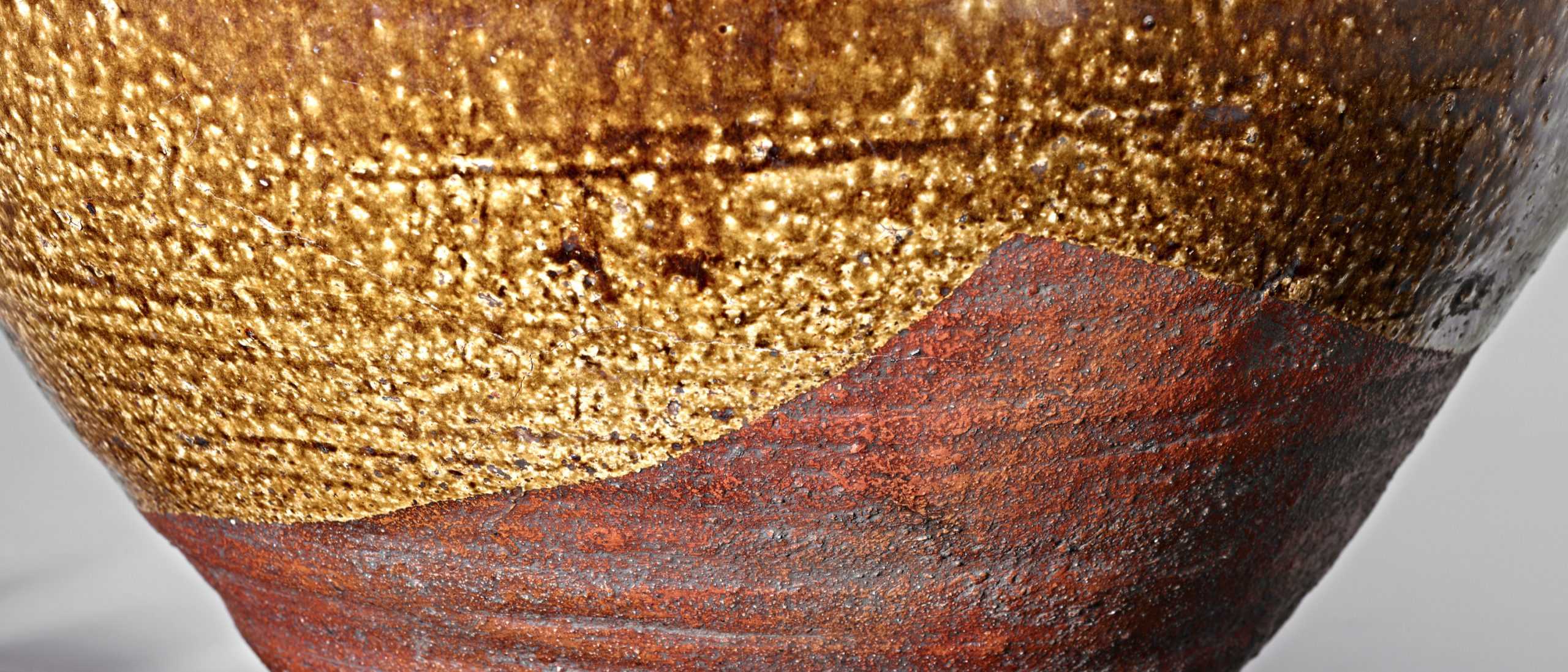
- ami:
- net bag (made for a tea-leaf storage jar)
- bokuseki:
- calligraphies by Chan/Zen monks
- cha:
- tea
- chaire:
- small ceramic jar for powdered tea
- chakaiki:
- tea diary
- chanoyu:
- Japanese practice centered on drinking powdered green tea and appreciating the objects used therein
- chanoyu nikki:
- tea diary
- chatsubo:
- tea-leaf storage jar
- chawan:
- tea bowl
- chio:
- lug cords (made for a tea-leaf storage jar)
- dōbōshū:
- curatorial advisor
- fukuro:
- pouch for a tea utensil, especially a container for powdered tea
- fukuroshi:
- pouch maker, a specialized artisan associated with chanoyu
- gyō:
- semiformal style; term employed in calligraphy and applied to levels of formality in chanoyu-related practices; see shin, sō
- haikenki:
- viewing records
- haikatsugi tenmoku:
- type of tenmoku tea bowl made at the Chayang kilns in Fujian Province; haikatsugimeans “ash covered,” which refers to the color and texture of the glaze
- hoguchi marks:
- the brightening in the glaze color caused by flames hitting the shoulder during firing; term of tea jar connoisseurship
- kaō:
- cipher
- karamono:
- object imported from China
- kin:
- unit of measurement, approximately 600 grams
- kiseikō:
- “yellow seikō,” type of tea jar named for its glaze color; see qingxiang
- koicha:
- thick tea; see usucha.
- koro:
- term of tea jar connoisseurship that means size
- kuchikiri or kuchikiri chaji:
- formal occasion for opening the sealed jar and serving the new tea
- kuchioi:
- mouth cover (made for a tea-leaf storage jar)
- kuchio:
- cord for securing mouth cover
- matcha:
- powdered green tea, prepared for drinking by whisking with hot water in a tea bowl
- matsubo:
- “true jar”; term that distinguishes Chinese tea jars from Japanese products
- meibutsu:
- “celebrated object”
- meibutsugire:
- “celebrated textiles” imported from China
- meibutsuki:
- “records of celebrated objects”
- mon:
- unit of currency
- Mushanokōji Senke:
- one of three Sen family lineages of chanoyu
- nadare:
- drips or flows of glaze; term of tea jar connoisseurship
- nagao:
- long cord (made for a tea-leaf storage jar)
- nanban:
- term describing the origins of an object made in Southeast Asia and imported into Japan
- nari:
- term of tea jar connoisseurship that means shape
- ōmeibutsu:
- “great meibutsu”; refers specifically to an object singled out by the mid-sixteenth century
- Omotesenke:
- one of three Sen family lineages of chanoyu
- ōtsubo:
- large jar
- qingquan (Chinese):
- mark on jar indicating “clear and perfect” (Japanese: seizen)
- qingxiang (Chinese):
- mark on jar indicating “clear and fragrant” (Japanese: seikō)
- Raku:
- family workshop in Kyoto that has produced low-fired, lead-glazed ceramics from the sixteenth century to the present day
- renga:
- linked verse
- rengeō:
- “lotus king” mark on jar; used in Japan as the name for a type of jar
- rokurome:
- horizontal grooves created by turning on the potter’s wheel; term of tea jar connoisseurship
- Ruson (Luson) tsubo:
- narrowly designates Chinese jars taken to Japan from the Philippines in the 1590s but came to be used for all Chinese tea jars
- seikō:
- “pure fragrance”; an inscription often stamped on Chinese jars; used in Japan as the name for a type of jar
- Senke jisshoku:
- group of ten specialized artisan families associated with the three Sen lineages of chanoyu
- shifuku:
- custom-tailored drawstring pouch for a tea utensil, especially a container for powdered tea
- shimofukura:
- “swollen lower body”; term of tea jar connoisseurship
- shin:
- formal style; see gyō, sō
- shō (祥):
- auspicious graph present on base of Chigusa
- sō:
- informal style; see gyō, shin
- tencha:
- dry, unrolled green tea leaves; raw material for matcha
- tenmoku:
- type of dark-glazed tea bowl made at the Jian kilns in Fujian Province; see haikatsugi tenmoku
- toko or tokonoma:
- alcove in tearoom for the display of objects
- Tomita kinran:
- name given in Japan to a Chinese textile of a particular pattern in a gold-brocaded weave structure (kinran)
- torio:
- securing cord (made for a tea-leaf storage jar)
- tōyama:
- “distant mountains”; term of tea jar connoisseurship coined in Japan to describe incised undulating pattern on large jars
- tsubo:
- jar
- uchiai:
- overlapping glaze effect; term of tea jar connoisseurship
- Uji:
- famous tea-producing area south of Kyoto
- Urasenke:
- one of three Sen family lineages of chanoyu
- usucha:
- thin tea; see koicha
- uzurame:
- “quail-eye” pattern in Chigusa’s glaze; term of tea jar connoisseurship
- yōsu:
- overall appearance of an object; term of tea jar connoisseurship
Chigusa and the Art of Tea is organized by the Smithsonian’s Freer Gallery of Art and Arthur M. Sackler Gallery with major funding from:
Toshiba International Foundation—25 years of supporting the arts
In celebration of its twenty-fifth anniversary, the Toshiba International Foundation is honored to be the lead sponsor for Chigusa and the Art of Tea and the publication of the same name. The foundation’s generous support allows the Freer Gallery of Art and the Arthur M. Sackler Gallery, the Smithsonian’s museums of Asian art, to present a range of exciting programs focused on Japanese arts and culture.
Dr. Sachiko Kuno and Dr. Ryuji Ueno
Jay and Toshiko Tompkins
Anonymous
Friends of the Freer|Sackler
Additional support for the exhibition publication is provided by the Barr Ferree Foundation Fund for Publications, Department of Art and Archaeology, Princeton University.
We gratefully acknowledge Omotesenke Fushin’an, Kyoto, Japan, and Omotesenke Domonkai Eastern Region USA, Inc. for their guidance.
Keep Exploring
-
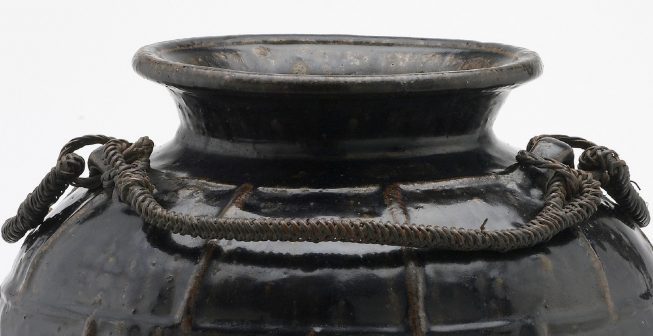
Storage Jars
March 15, 2014–June 28, 2015
-
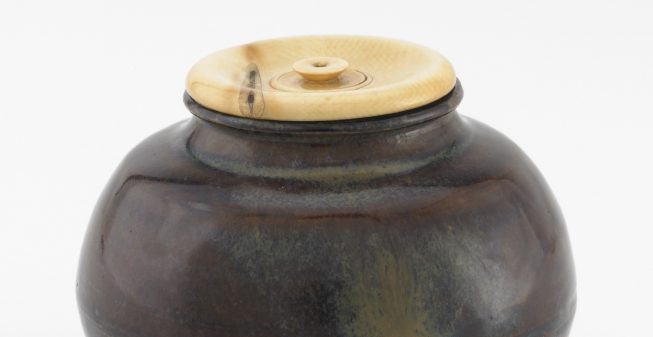
Chinese Ceramics for Tea in Japan
March 8–September 14, 2014
Tea-leaf storage jar named Chigusa; China, probably Guangdong Province; Southern Song or Yuan dynasty, mid-13th–mid-14th century; Stoneware with iron glaze; 41.6 cm (h); F2016.20.1
- Jump To...

